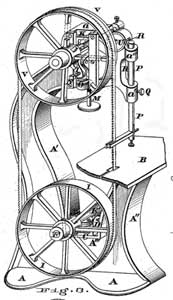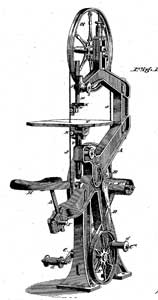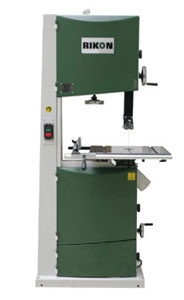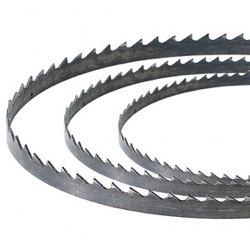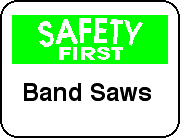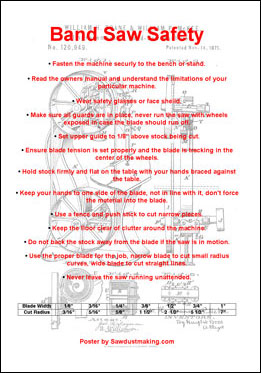
"Helping woodworkers online for the past 20 years"
Band Saws
A band saw is a power tool which uses a blade consisting of a continuous band of metal with teeth along one edge which rides on two or more wheels rotating in the same plane. Band saws range in throat capacity from 8" to 36", with either two or three wheels for the blade. Blades for the home shop range from 1/8" to 1" wide, the narrow blades are used to cut small radius curves, the wide blades are used for straight cuts such as resawing. The smaller three wheel style is not that popular as the blades tend to break frequently due to the small curvature around the wheels. |
Early Band Saws |
Powered Band Saw 1871
|
Pedal Band Saw 1877
|
14" Band Saw Be aware that manufactures seem to list band
saws based on the diameter of the wheels, not the throat capacity, a
14" saw will often only have a throat capacity of around 13 1/2". A
good quality band saw properly set up it will become one of the most
used tools in your shop. Choose at least a 14" model if you plan to do
much resawing, the smaller models are a bit too light. Most
would choose a band saw over a table saw if only one of them could be
had, they are so much more versatile. Cutting dados is not possible on
a band saw but they can be done on a router. The
only downside is that they require more set up than any other tool in
the shop, different operations require different blades, each time a
blade is changed the saw has to be tuned to that particular blade. Many
shops eventually end up with a large machine for heavy work and a
smaller machine with a narrower blade for fine work.

A good entry level machine.
Tuning a Band Saw
|
Unplug bandsaw when installing and centering blade.
Adjust tilt of top wheel so the gullets of the teeth are running dead center on the wheels, spin the top wheel by hand to check. The tension should be just enough to prevent slipping on the wheels but not enough to stretch the blade, the wider the blade the more tension required. If there is too little tension the blade will not cut straight, increase a bit at a time until you feel you can control the cut. Some inexpensive or damaged blades will wander no matter what you do. Set guide blocks to miss the teeth but support the rest of the blade. Wrap a single layer of 24# paper around the blade to set the side clearance. The back up roller should be set so it does not turn when idling but will support the blade when cutting. Condition the back of the blade, with the blade running hold a sharpening stone against the back corners of the blade to round them off, this will allow you to cut sharper corners with less binding. Check if table is set square to blade, otherwise your cut will not be 90 degrees. Set fence to blade, most band saws do not cut parallel to edge of table so the fence has to be adjusted accordingly. Mark a line about 3" from and parallel to the straight edge of a 12" square scrap of plywood, make a cut into plywood following the line for about six inches. Stop the saw, keeping the plywood in the position it was in while making the cut. Align the fence to the straight edge of the plywood. There are many variables when setting a band saw, each blade will have its own characteristics, often you may find that you have to go back and tweak some of the previous settings again as you go through the procedure. It can be a time consuming exercise, but well worth it in the long run. Before adjusting your saw watch this video by Carter, it is the best explanation I have ever run across: http://www.youtube.com/watch?feature=player_embedded&v=wGbZqWac0jU |

